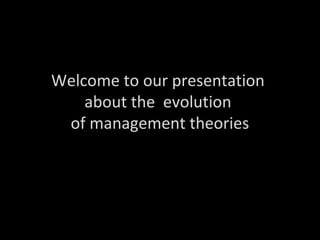
Evolution of management theories
- 1. Welcome to our presentation about the evolution of management theories
- 3. • Few workmen • Very Skilled and qualified • Customized cars • Workman : – Director – Manufacturer – Salesman
- 4. Disadvantages • Manufacturing costs extremely high • Maintenance and repair costs very high • No Research and Development
- 5. Henri Fayol (1841-1925) • One of the most influential contributors to modern concepts of management • Father of modern operational management theory • General and Industrial Management (1916)
- 6. Biography • Educated at “Ecole des Mines” in St. Etienne • Almost 60 years of experience as an engineer and Director at “Houilleres de Commentry” • 1916: Publication of “General and Industrial Management”
- 7. Theory • Fayol’s theory holds that there are five primary functions of management: (1) Planning: (2) Organizing: (3) Commanding: (4) Coordinating: (5) Controlling:
- 8. Theory • Modern management theories (e.g. Richard Daft) have reduced the five functions to four: (1) Planning (2) Organizing (3) Leading (4) Controlling
- 9. The Classical School of Management
- 10. Taylorism Taylor : a Quaker! • Principles 1: Replace rule-of-thumb work methods with methods based on a scientific study of the tasks. • « the natural instinct and tendency of men is to take it easy » F.W.TAYLOR • Principle 2 • Scientifically select, train, and develop each employee rather than passively leaving them to train themselves. • « they sould...do what they are told to do promptly and without asking questions or making suggestions » F.W. TAYLOR
- 11. Taylorism • Principle 3 • Provide "Detailed instruction and supervision of each worker in the performance of that worker's discrete task". • Principle 4 • Divide work nearly equally between managers and workers, so that the managers apply scientific management principles to planning the work and the workers actually perform the tasks. • « The Work of every workman is fully planned out by the management , each man receive complete written instructions ,... This task specifies not only what is to be done but also how it is to be done and the exact time allowed for doing it » F.W. TAYLOR
- 12. Henry Ford (1863-1947) • Father of modern assembly lines • Mass production • Model T automobile • Prolific inventor (161 U.S. patents)
- 13. Philosophy of Fordism • Widespread prosperity and rise corporate profits How ? • High wages allow the workers to purchase the output they produce. The idea : Convert workers into customers
- 14. Division of labor • Distinctive division of labor allows complex tasks to be divided into several simple and repetitive one. • Skilled labor is no more needed in the production.
- 15. Standardisation -Major issue of custom made cars : Each producers have -Hand-made steel parts have to their own parts and be recalibrate after beeing components. (even not the quenched. same metric system) -Ford invented a process to directly shape parts out of a quenched steel block.
- 16. Optimize the working space • Typically similar machinery are installed one next to another. • Ford rearrange them into the correct sequence to follow the production patern. • Various parts of the production process are linked together by a moving conveyor belt : "Bring the work to the workers."
- 17. Disadvantages Advantages
- 18. Alfred P. Sloan (1875-1966) • A pure product of the MIT… – Graduated in electrical engineering in 1895, at 20 – Member of ΔΥ fraternity – Founded in 1950 the School of Industrial Management
- 19. … & A selfmade man, 1937-1956 1923-1946 1918 1916 1899 1895
- 21. Sloan’s Marketing approach • Establishing annual styling changes planned obsolescence • Impeding alternative transports to car monopolysing • Pricing discrimination • Market segmentation
- 22. Sloan’s pricing discrimination Price / Quality r pl ye p Su Mkt $! Co ns um er Quantity
- 23. #1 #2 The 2515 Brands car in after Manufacturer forin 2007 1967 The 100 Millionth Years 1930-2006 Manufacturer 76 75 50 1962 1955 1945
- 24. Toyota Production System • A production system was developed between 1948 and 1975 for Toyota Motor company by: – Taiichi Ohno, – Shigeo Shingo – Eiji Toyoda
- 25. • Difficulties for the company : – Small market with high competition – Poor consumers
- 26. Aim • Eliminate all muni, mura, muda (overburden, inconsistency, waste) from the operation to stay competitive.
- 27. Toyota Production System House
- 28. Just in time production • Created by the founder of Toyota : Sakichi Toyoda, his son Kiichiro Toyoda and the engineer Taiichi Ohno. • Based on the 7 wastes: – over-production – motion (of operator or machine) – waiting (of operator or machine) – conveyance – processing itself – inventory (raw material) – correction (rework and scrap)
- 29. Jidoka • TPS emphasizes the participation of all employees. • Toyota organized their workers by forming teams • Each team has a leader who also works on the line • Teams are responsible for : – Training to do many specialized tasks. – Housekeeping and minor equipment repair.
- 30. Jidoka • Product defects must be discovered as soon as possible. • Workers are responsible for the discover of defects. • Workers are able to stop the entire line by pulling a cord (Jidoka). • Workers are controlling machine’s work.
- 31. • Global Warming • Financial crisis • Energy crisis • Unemployment • …
